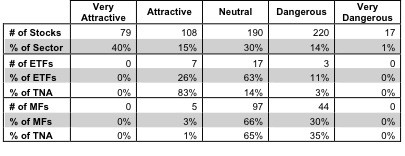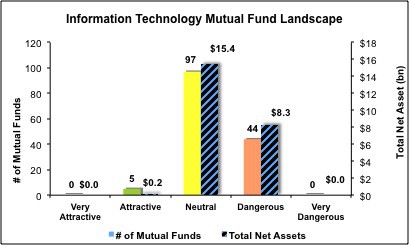The Information Technology sector ranks second out of the ten sectors as detailed in my sector rankings for ETFs and mutual funds. It gets my Neutral rating, which is based on aggregation of ratings of 27 ETFs and 146 mutual funds in the Information Technology sector as of October 9, 2012. Prior reports on the best & worst ETFs and mutual funds in every sector and style are here.
Figures 1 and 2 show the five best and worst-rated ETFs and mutual funds in the sector. Not all Information Technology sector ETFs and mutual funds are created the same. The number of holdings varies widely (from 25 to 416), which creates drastically different investment implications and ratings. The best ETFs and mutual funds allocate more value to Attractive-or-better-rated stocks than the worst ETFs and mutual funds, which allocate too much value to Neutral-or-worse-rated stocks.
To identify the best and avoid the worst ETFs and mutual funds within the Information Technology sector, investors need a predictive rating based on (1) stocks ratings of the holdings and (2) the all-in expenses of each ETF and mutual fund. Investors need not rely on backward-looking ratings. My fund rating methodology is detailed here.
Investors seeking exposure to the Information Technology sector should buy one of the Attractive-or-better rated ETFs or mutual funds from Figures 1 and 2.
See ratings and reports on all ETFs and mutual funds in this sector on my free mutual fund and ETF screener.
Figure 1: ETFs with the Best & Worst Ratings – Top 5
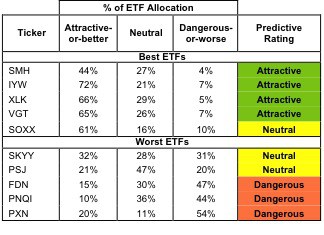 * Best ETFs exclude ETFs with TNA’s less than 100 million for inadequate liquidity.
* Best ETFs exclude ETFs with TNA’s less than 100 million for inadequate liquidity.
Sources: New Constructs, LLC and company filings
Four ETFs are excluded from Figure 1 because their total net assets (TNA) are below $100 million and do not meet our liquidity standards
Figure 2: Mutual Funds with the Best & Worst Ratings – Top 5
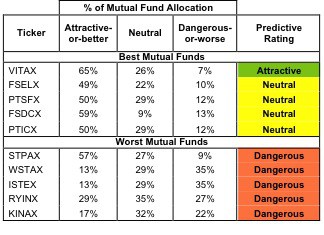 * Best mutual funds exclude funds with TNA’s less than 100 million for inadequate liquidity.
* Best mutual funds exclude funds with TNA’s less than 100 million for inadequate liquidity.
Sources: New Constructs, LLC and company filings
Eleven mutual funds are excluded from Figure 2 because their total net assets (TNA) are below $100 million and do not meet our liquidity standards.
Market Vectors Semiconductor ETF (SMH) is my top-rated Information Technology ETF and Vanguard World Funds: Vanguard Information Technology Index Fund (VITAX) is my top-rated Information Technology mutual fund. Both earn my Attractive rating.
PowerShares Lux Nanotech Portfolio (PXN) is my worst-rated Information Technology ETF and Kinetics Mutual Funds, Inc: Internet Fund (KINAX) is my worst-rated Information Technology mutual fund. Both earn my Dangerous rating.
Figure 3 shows that 187 out of the 614 stocks (over 55% of the total net assets) held by Information Technology ETFs and mutual funds get an Attractive-or-better rating. Seven out of 27 Information Technology ETFs (more than 83% of total net assets) get an Attractive-or-better rating, while only five out of 146 Information Technology mutual funds (less than 1% of total net assets) get an Attractive-or-better rating. ETFs do a much better job of allocating to Attractive-or-better stocks. Mutual fund managers do a relatively poor job of investing in good stocks.
The takeaway is: mutual fund managers investing practices do not justify their costs.
Figure 3: Information Technology Sector Landscape For ETFs, Mutual Funds & Stocks
As detailed in “Cheap Funds Dupe Investors”, the fund industry offers many cheap funds but very few funds with high-quality stocks, or with what I call good portfolio management.
Investors need to tread carefully when considering Information Technology ETFs and mutual funds, as only twelve are worth buying. Only seven ETFs and five Information Technology mutual funds in the Information Technology sector allocate enough value to Attractive-or-better-rated stocks to earn an Attractive rating.
Oracle Corporation (ORCL) is one of my favorite stocks held by Information Technology ETFs and mutual funds and earns my Very Attractive rating. ORCL is a leading provider of database products and services. Despite being the leader in an industry on which our data-centric world depends, ORCL has a Price-to-Economic Book Value of .90, which means the market expects its after-tax profits to permanently decline by 10%. This pessimistic valuation is surprising given that ORCL has had positive economic earnings every year since 1998 and has grown them at an annual CAGR of 25%. It is not often that an industry leader that creates value for shareholders year-after-year is sold at a discount. ORCL earns my Very Attractive rating.
Research Frontiers, Inc. (REFR) is one of my least favorite stocks held by Information Technology ETFs and mutual funds and earns my Dangerous rating. Unlike ORCL, REFR has never earned positive economic earnings in any of the past 14 years. REFR currently demands a 64 Price/Sales ratio. These are incredible expectations for a stock that has yet to earn even accounting profits, let alone economic earnings. This makes REFR a Dangerous stock.
529 stocks of the 3000+ I cover are classified as Information Technology stocks, but due to style drift, Information Technology ETFs and mutual funds hold 614 stocks.
Figures 4 and 5 show the rating landscape of all Information Technology ETFs and mutual funds.
Our sector rankings for ETFs and mutual funds report ranks all sectors and highlights those that offer the best investments.
Figure 4: Separating the Best ETFs From the Worst ETFs
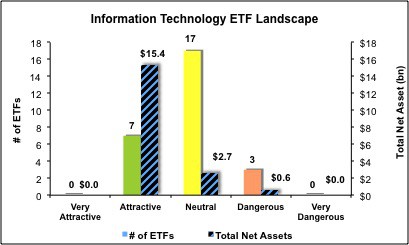 Sources: New Constructs, LLC and company filings
Sources: New Constructs, LLC and company filings
Figure 5: Separating the Best Mutual Funds From the Worst Mutual Funds
Review my full list of ratings and rankings along with reports on all 27 ETFs and 146 mutual funds in the Information Technology sector.
Disclosure: I own ORCL. I receive no compensation to write about any specific stock, sector or theme.

